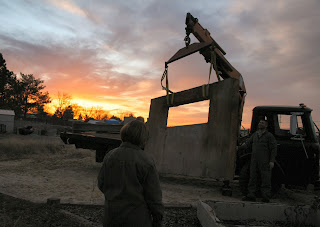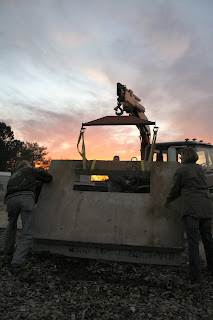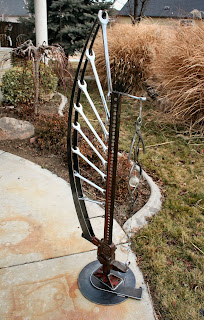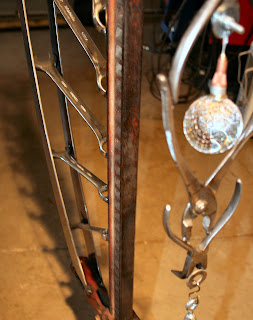Next we will submit files for the attachment plates, the center-pipe, & the plumb-bob. Hopefully we will have everything back & ready to assemble in mid-March. If we have planned it all out correctly, the pieces should go together like a puzzle. Crossing my fingers, anyway....

I managed to score some perfect lenses this week too; I got a message from the Reuseum that he had some that just arrived, & I rushed down the next day; they are 5 inches in diameter & practically new!!! Perfect! These will go into the piece that looks kinda like a sextant; one on each side to magnify the scale. I will also be adding some smaller lenses to the plumb-bob: more on that later....

And, we met with the Pro. Land Surveyors of Idaho; gave a brief overview of the project & asked if they might be interested in donating some cool surveying artifacts to the project. It turns out, the big state conference is next month, & they are doing a re-dedication of Initial Point---interesting how closely it ties in with my project.... They invited me to come to the conference & present the project in front of about 300 Professional Surveyors from around the state! OMG: I'm a bit nervous about that, but I'll do my best... They also gave me a replica of the marker that is out at Initial Point to use in the alcove art, & agreed to put the world out for cool artifacts. Check out this article in the Boise Weekly for the details on the Initial Point Dedication: a very cool write-up last week...
 Since the meeting, I got word that we will be receiving quite a few really cool pieces to use!! We also met with Clint at Land Solutions: they did the surveying for the City Hall property. He has volunteered to come in & give us the exact coordinates of the center of the art piece when it's done. A very cool detail to add in somewhere; I'm very excited that so many people are getting involved! The support for this project has been amazing!
Since the meeting, I got word that we will be receiving quite a few really cool pieces to use!! We also met with Clint at Land Solutions: they did the surveying for the City Hall property. He has volunteered to come in & give us the exact coordinates of the center of the art piece when it's done. A very cool detail to add in somewhere; I'm very excited that so many people are getting involved! The support for this project has been amazing! That's all for now; check back soon for updates :)
Amber
 After bouncing through the sand & almost getting stuck, here we are ready to start unloading...
After bouncing through the sand & almost getting stuck, here we are ready to start unloading...


 Don't get any ideas, Mom; his life insurance isn't that great....
Don't get any ideas, Mom; his life insurance isn't that great....

 And, we made another crypt... Too funny; actually, this will make a lovely seating area, & there are berry bushes planted already that will grow up through the void. I may add a few sculptural touches too, since there are threaded holes in the top. After staining, & when the rest of the plantings grow up a bit, it's going to make a lovely bench area :)
And, we made another crypt... Too funny; actually, this will make a lovely seating area, & there are berry bushes planted already that will grow up through the void. I may add a few sculptural touches too, since there are threaded holes in the top. After staining, & when the rest of the plantings grow up a bit, it's going to make a lovely bench area :)


























